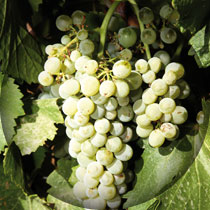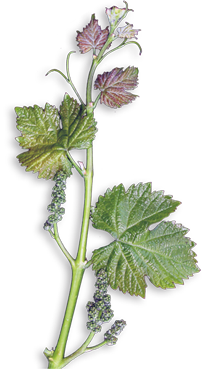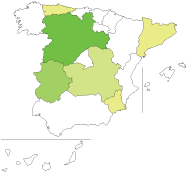Verdejo (ES)
Variety: white | Category I | Spain


General Information
Verdejo


Origin: Known since the 15th century in Castile and Leon in the provinces of Avila, Segovia, and Valladolid. The high elevations around Rueda, with their special climate, are closely associated with this variety (over 6,000 ha under cultivation). Lorenzo (1978) traces the origin of this variety back to the Mozarabs of the 11th century who lived in La Algaida in Cadiz, who were subsequently driven from the area after the Battle of Toledo in 1085 and with the revival of Iberian viticulture in the 12th century migrated to the Douro area around Castile. In the centuries that followed, Cistercian monks dedicated themselves to the selection of this variety in the Lands of Medina (Medina del Campo, D.O. Rueda, Valladolid), which distinguished itself in the 16th century because of its special quality, and would have been very different from the aromatic dessert wines of West Andalusia at the time. In 1755 Livoy and Sprünglin made mention of the variety. With the modern cold fermentation techniques, this variety has experienced a significant upswing since the end of the 20th century, and ongoing regional expansion.
Chief areas of distribution: Castile and Leon.
Official synonym(s) (national and OIV): None.
Historic and regional synonyms: Verdeja.
Homonym(s): Verdejo tinto in Asturia, Verdelho (PT), Verdello (ES), Verdello (IT). Much confusion exists in Portugal because of the morphological similarity with the Portuguese variety, Verdelho (Madeira), as well as with the ampelographically different Gouveio which prior to 2000 was also referred to as Verdelho in the Dão, Douro and Alentejo regions.
Area under cultivation: 11,000 ha (Ministry of Agriculture, 2007).
Trend: Upward.
Varietal variability: Medium to low.
Availability of propagating material: Certified clones are available: CL-4, CL-6, CL-21, CL-34, CL-47, CL-77, CL-101.
Molecular Profile (OIV)
Regional Classification
Morphology
Phenology
Vegetative Potential
Viticultural Parameters
Oenology
Variety Characteristics
| VVMD5 | VVMD7 | VVMD27 | VVS2 | ZAG62 | ZAG79 | ||||||
| Allele1 | Allele2 | Allele1 | Allele2 | Allele1 | Allele2 | Allele1 | Allele2 | Allele1 | Allele2 | Allele1 | Allele2 |
| 222 | 234 | 237 | 255 | 179 | 185 | 150 | 156 | 185 | 193 | 249 | 249 |
Young shoot (form of tip): Very open, erect hairs, colouration medium to weak.
Young leaf: Medium anthocyanin colouration of first six leaves, sparse hairs.
Young shoot: Green at nodes and internodes, dorsal and ventral sides.
Inflorescence (sex of flower): Hermaphrodite.
Mature leaf: Mature leaf, medium to small, pentagonal, five lobes. Half open U-shaped petiolar sinus. Medium sized veins, anthocyanin colouration to the first lateral veins, rolled profile in cross-section, medium undulation of slightly overlapping upper lateral sinuses. No hairs or sparse hairs between main veins and on main veins. No hairs on petiole. Large, broad rectilinear convex teeth.
Bunch: Medium to small, dense, short peduncle.
Berry: Medium size, uniform, dense, difficult to detach, thin skin. Flesh colourless, soft.
Woody shoot: Yellowish-brown, striped.
Time of bud burst: Normal to late.
Flowering: Medium.
Berry (colour change): Medium.
Berry (harvest ripe): Medium to late.
Vigour of shoot growth: Medium.
Pruning weight:: Medium to heavy.
Shoot attitude (habit): semi-erect, with drooping long shoots.
Length of internodes: Medium.
Shoot length: Medium to long.
Tendency to form lateral shoots: Risk of numerous shoots forming at second node.
Rate of multiple bud bursts: Infrequent.
Bud fertility index: The medium to low fertility is terroir-dependent.
Yield: Moderately regular.
Crop uniformity: Moderately homogeneous.
Sensitivity to abiotic factors: Spring frost.
Systemic viral infection prior to selection: Susceptible to all fungal diseases, with very dense clusters being most susceptible.
Susceptibility to Pests: Susceptible to pests.
Bunch size: Medium.
Bunch density: Medium.
Seeds per berry: 3-4.
Vineyard conduction system: Traditionally trained on the goblet system, but modern wire frame system now used.
Pruning: A balance has to be achieved in keeping with the terroir between canes and woody shoots. More and more often, the Guyot is being chosen, with mixed pruning, so that the plagiotropic shoot attitude of the vine can be adapted to the trellising system.
Green pruning: Strongly recommended to assist the maturing process, and the following year's pruning.
Soil requirement: Drought tolerant, and suitable for poor, stony and loose soils. The quality of this variety does improve in somewhat more fertile soils.
Climatic requirements: Dry, with (not extremely) calcareous soils.
Vine density: 2,000 – 3,000 vines/ha.
Rootstock: Low degree of incompatibility. 1103 P and So4 are recommended.
Incidence of coulure/millerandage: Low.
Spoilage of mature berries: Medium stability.
Risk of bird damage: No special risk.
Machine harvest suitability: Suitable.
Hand harvest suitability: Somewhat expensive.
Wine type: In the Northern Meseta this variety is blended with the Palomino to produce a dessert wine, but nowadays is predominantly produced as a varietal, or blended with a small percentage of Sauvignon or Macabeo to produce a young, aromatic, cold fermented, or barrel-fermented table wine. This variety is also suitable for the production of sparkling wine.
Potential alcohol content: Medium increase in sugar content of must.
Natural acidity of must: Medium to high.
Total anthocyanins: None, or few.
Risk of oxidation of must: Medium.
Tendency towards acidity loss in fermentation: Low.
Colour intensity of wine: Low.
Wine colour tonality: Clear, with light green reflexes.
Tannins: Low or none (except when barrel fermented or aged).
Total polyphenol index (at 280 nm): 6.7.
Risk of oxidation of wine: Medium.
Aromatic profile: Very strong, with citrus tones and exotic notes, and a hint of bitter almonds.
Ageing Potential: Quite high.
Blending recommendation: Blends well with Sauvignon Blanc and Macabeo.
Wine Descriptors: The wines are characterised by straw yellow colouration with light green reflexes. The pronounced initial aroma is multi-layered, composed of fruity, floral, and grassy notes, and has slightly bitter tones, with a hint of acidity. The wine has a robust structure and strong body which, owing to its high glycerol content, presents itself as soft and well-rounded. In the mouth, the aromas endure, leaving an impressive after-effect of the most diverse fruity notes. (Itacyl 2008).
Wine quality: Very high.
Variety Characteristics: Very high. The grapes from this variety have produced one of the most convincing white wines on the Iberian Peninsula.

